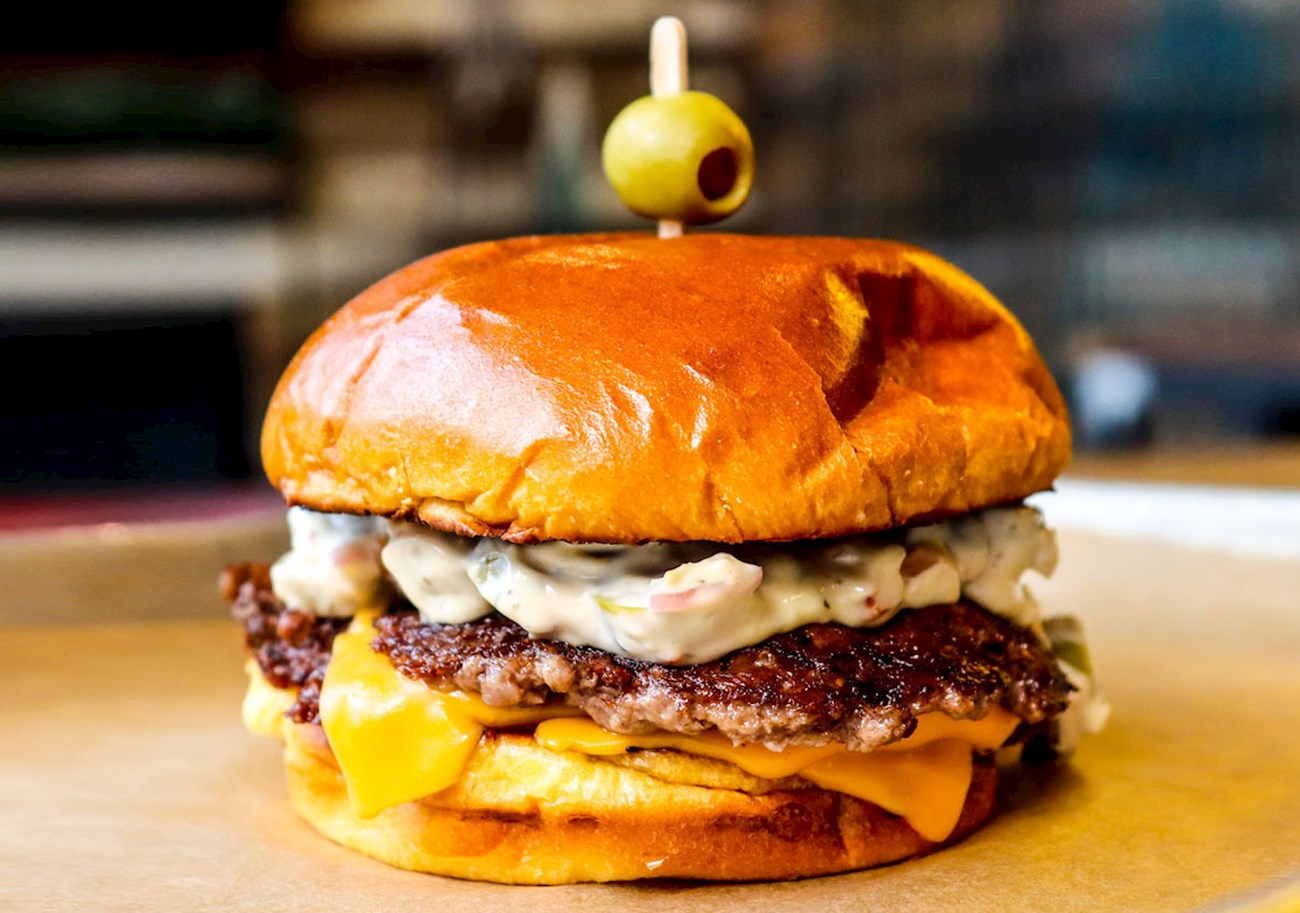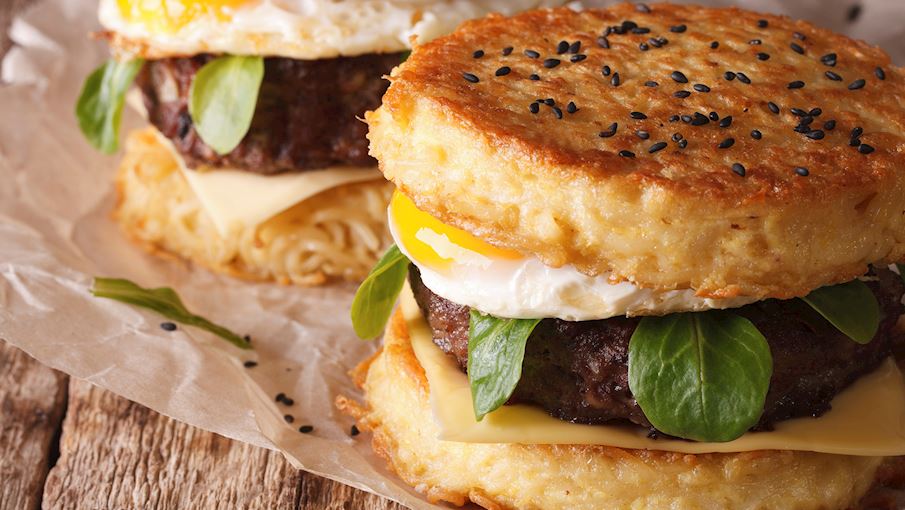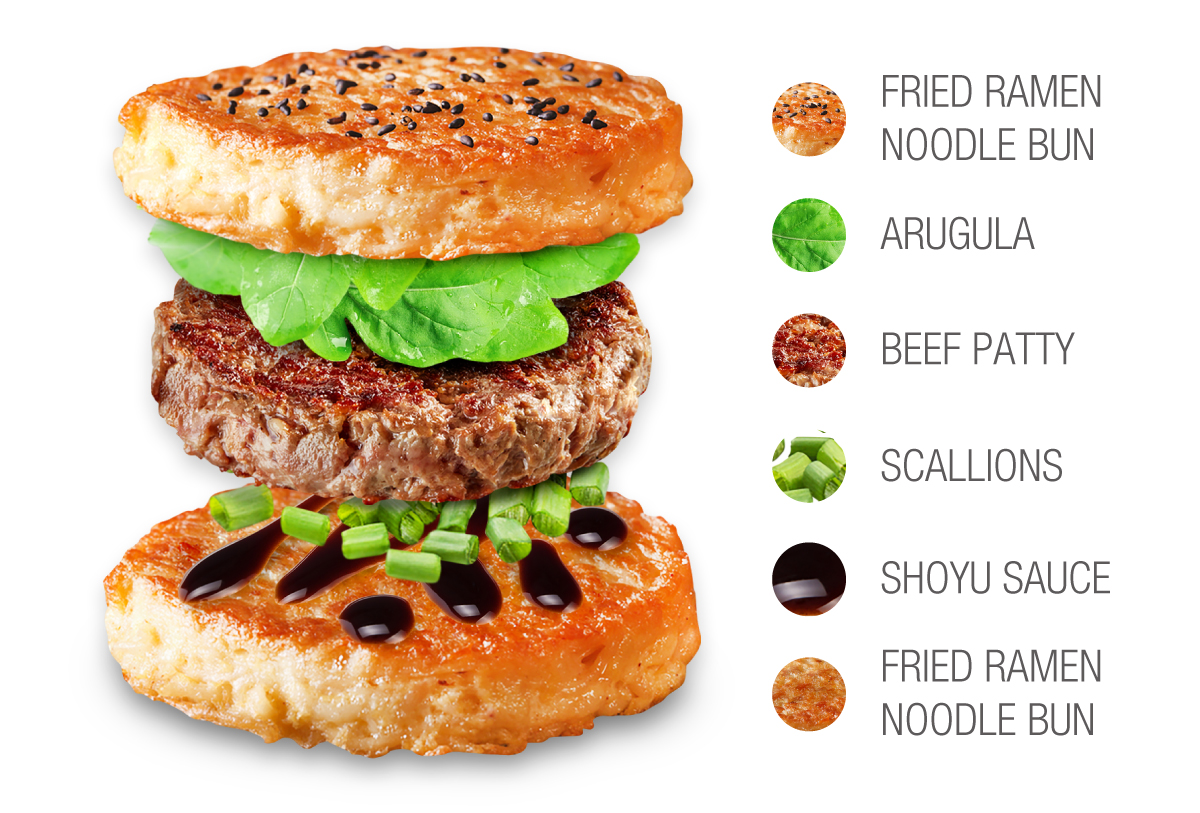Ramen burger is a unique variety of a hamburger consisting of a meat patty that is sandwiched between two fried ramen noodle buns. The meat patty is typically slathered in shoyu sauce and topped with arugula and scallions. The dish was created by Keizo Shimamoto, a ramen blogger, who debuted it in 2013 in Brooklyn.
The ramen burger was so popular that it had been voted by Time Magazine as one of the 17 most influential burgers ever created.
MAIN INGREDIENTS
Olive burger is an American burger variety originating from Michigan. It’s made with a combination of ground beef, oil, white buns, mayonnaise, and pitted green olives. In order to prepare it, the meat patties are fried, topped with a mixture of olives and mayonnaise, then placed in a burger bun with no other condiments.
Some like to add a bit olive brine to the olive-mayo mix, while others put the mayonnaise on a bun, and the patties are topped with olives before they’re placed into the buns. There are many theories about the origins of this burger, and some people claim that Olympic Broil in Lansing made the first olive burger in the 1960s, while others say it was made much earlier at Kewpee Hotel Hamburgs in Grand Rapids.
MOST ICONIC Olive Burger
View moreMAIN INGREDIENTS
Slugburger is an American burger variety with origins in Corinth, Mississippi. Despite its unusual name, it is not made with slugs, but gets its name from the Depression-era practice of combining ground meat with fillers such as potato flour or soybeans.
Slugburger was first named Weeksburger, after its inventor, John Weeks. The burgers originally cost a nickel, and nickels were called slugs at the time, so the name slugburger has remained unchanged until today. Meat patties are typically fried in canola oil and served topped with pickles, mustard, and onions on a small hamburger bun.
With more than 1000 calories and usually over 45 grams of fat per serving, Luther burger is one of the world's unhealthiest burgers, but its flavors and a unique combination of ingredients make up for it. The standard burger bun is replaced by a sliced, sugar-glazed donut (usually a Krispy Kreme).
Aside from that, Luther is basically a cheeseburger topped with bacon, and it is typically served without vegetables or condiments. Many people believe that it was invented at Mulligan's Bar in Georgia, when the cook ran out of standard hamburger buns and used donuts instead.
MAIN INGREDIENTS
Steamed cheeseburger or cheeseburg is a unique cheeseburger variation originating from Connecticut. Unlike regular burgers, this local specialty is made with steamed ground beef and steamed chunks of cheese (usually cheddar). They are both steamed separately, the beef in special metal molds, and the cheese in separate containers.
Once done, cooks place the steamed patties on bread rolls, then top it with melted cheese, with the optional addition of condiments, tomatoes, and lettuce. It is believed that this cheeseburger was invented in the 1920s or 1930s at Jack's Lunch in Middletown, and nowadays the most popular joint that serves steamed cheeseburgers is Ted's Restaurant in Meriden, which is still attracting adventurous eaters to the city.
MAIN INGREDIENTS
A slopper is basically a hamburger or a cheeseburger with a grilled bun, served drenched in red or green chili. It is sometimes topped with french fries, avocados, or onions. It is believed that slopper was invented either at Gray's Coors Tavern or the Star Bar in Pueblo, Colorado in the 1950s or the 1970s, depending on who you ask.
The burgers can be served regularly (with bread on top and on the bottom) or open-faced, and they are typically consumed with a knife and a fork.
MAIN INGREDIENTS
Chili burger is a variety of hamburger consisting of a bun and a meat patty that is topped with chili con carne, although the chili might also be served on the side. The hamburger is served open-faced in some places, and it is often topped with cheese and onions, while fries are usually served as an accompaniment.
It is believed that chili burger was invented in the 1920s by Thomas M. DeForest in Los Angeles.
Pastrami burger consists of a toasted sesame seed bun filled with a beef patty that is topped with pastrami, cheese, tomatoes, shredded lettuce, onions, and fry sauce – a combination of ketchup, mayonnaise, sweet relish, and onion powder.
It's an invention of a Greek man named James Katsanevas, who had a restaurant called Minos Burgers in Anaheim, California, and started serving the dish in the early 1970s, while pastrami was brought over to Los Angeles by the Jewish people who came over from New York City in the middle of the 20th century.
MOST ICONIC Pastrami Burger
View moreTheta burger is the name of an Oklahoma specialty consisting of a bread bun and a meat patty that is topped with hickory sauce, mayonnaise, slices of dill pickles, and shredded cheddar cheese. It is believed that the burger originated in the Split-T restaurant (now closed) in Oklahoma City, although some claim that it was invented in the 1930s or the 1940s by Ralph Geist, the owner of Town Tavern in Norman, Oklahoma.
Slaw burger is a traditional type of burger that's common in the southern parts of the United States. It's essentially a classic burger topped with coleslaw. In most cases, the burger consists of a meat patty that's topped with sliced tomatoes, sliced onions, and coleslaw dressing.
Some of the dressing is absorbed into the top bun for extra flavor. Everyone makes slaw burgers according to personal preferences, so it's not uncommon to include dill pickles, bacon, and cheese as well, but the only consistent element is the coleslaw topping.
TasteAtlas food rankings are based on the ratings of the TasteAtlas audience, with a series of mechanisms that recognize real users and that ignore bot, nationalist or local patriotic ratings, and give additional value to the ratings of users that the system recognizes as knowledgeable. For the “11 Worst Rated American Burgers” list until April 19, 2025, 2,840 ratings were recorded, of which 2,448 were recognized by the system as legitimate. TasteAtlas Rankings should not be seen as the final global conclusion about food. Their purpose is to promote excellent local foods, instill pride in traditional dishes, and arouse curiosity about dishes you haven’t tried.






